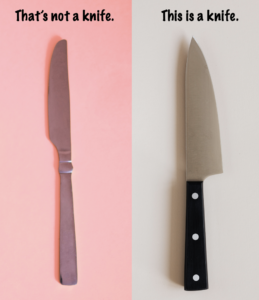 When we started cooking more frequently, one of our first lessons was…
When we started cooking more frequently, one of our first lessons was…
knives.
“You only need one,”
says Mark Bittman, NY Times cooking advice columnist. We now agree with Mark that all you really need to have a complete kitchen is a good Chef’s knife.
Mark says it well:
“A good paring knife is essential for smaller tasks like peeling, but they’re almost literally a dime a dozen at this point, so there’s really no point in stressing over which is the best. Bread knives are necessary for cutting, well, bread. But with these knives, it’s really the jagged serration that does most of the work so it’s not essential to get the sharpest tool possible. The Chef’s knife however, is a totally different animal. It needs to be a good one.”
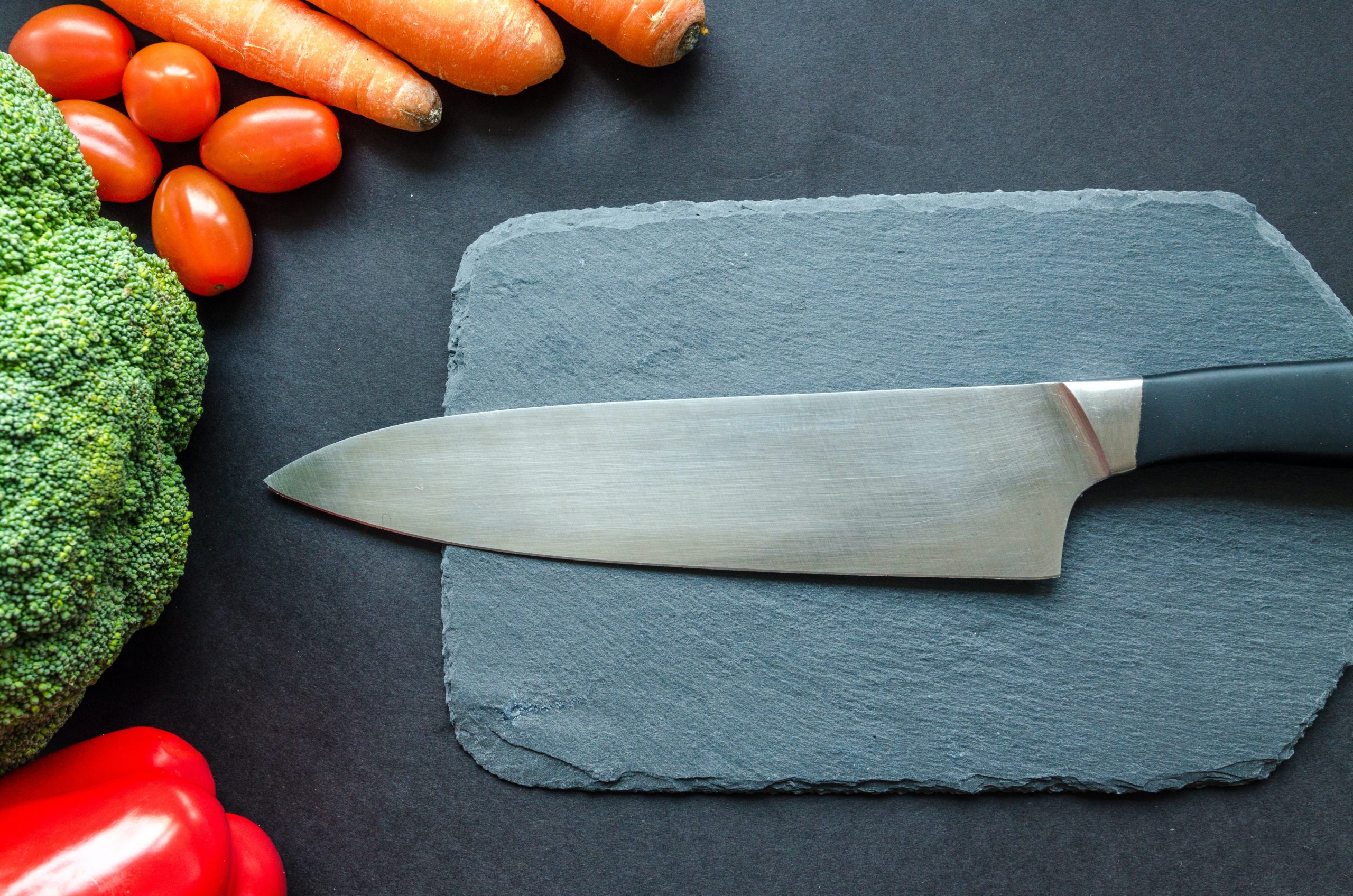 We have to admit we were a little (ok, a lot) reluctant when we first ordered our Chef’s knife — have you seen these things?
We have to admit we were a little (ok, a lot) reluctant when we first ordered our Chef’s knife — have you seen these things?
They are a little intimidating…we were sure we were going to lose a digit! But we decided to bite the bullet and invest in a good Chef’s knife — and we haven’t regretted it once! (And all fingers are still intact!) Our Chef’s knife is our favorite go-to knife and we would be lost in the kitchen without it! We even invested in a second one after we were fighting over who got to use it! We find it to be an excellent multi-purpose knife we can use for mincing, slicing, chopping vegetables, slicing meats, among others. You can even use it to quickly cut up a whole chicken (check out this video to see how)!
Which Chef’s knife is best?
There is no such thing as “the best one.”
It all comes down to personal preference and which one feels most comfortable and natural. It is kind of like buying a car…just not near as expensive!
Different knives have different features and, while you can buy one online, it is a great idea to “test drive” a few before you buy one. Ideally, you want to find one that feels like an extension of your hand. It should be comfortable and should instill confidence…not fear! Finding one with a good balance, where neither the handle nor the blade feel too heavy, is something to be on the lookout for.
Some other factors to consider when investing in a Chef’s knife:
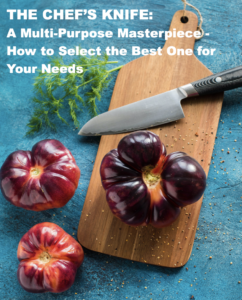 What length? While many professional chefs use 12 inch blades, the most popular size for home kitchens is 8 inches. Some prefer a 10 inch because of the larger cutting surface, but it all comes down to what feels most comfortable.
What length? While many professional chefs use 12 inch blades, the most popular size for home kitchens is 8 inches. Some prefer a 10 inch because of the larger cutting surface, but it all comes down to what feels most comfortable.
Western or Japanese? The Western knives (often made in France or Germany) tend to be heavier and more wedge-shaped. They also tend to have softer steel, making them easier to sharpen but requiring more frequent maintenance. Western knives tend to be better for people who have a lot of heavy duty cutting like cutting bones, chickens or heartier vegetables. Japanese knives tend to be lighter and have a thinner blade. They can be easier to maneuver and can stay sharper longer. They may not rock back-and-forth as smoothly because the blades tend to have less of a curve than the Western-style knives. A Japanese-style knife can be a good option if you do a lot of work with vegetables like chopping, mincing and slicing.
A third style that is not currently as popular is the Santoku knife. It is typically shorter than the Chef’s knife (often 6 to 7 inches) and the blade is straighter, meaning it has limited “rocking” action. The Santoku can have a pattern that helps to release food after slicing, reducing those pesky pieces that stick to the knife.
Forged or stamped? Most people prefer forged knives because they tend to be stronger. This is because the knife comes from a single bar of steel and is heated and pounded into shape. Forged knives often contain a “bolster,” which is a mound of metal between the handle and the blade. Many people feel like this provides a safe place for their fingers when using the knife. A stamped knife is “stamped” out of a continuous flat sheet of steel. The handle is then added and the knife is sharpened. Stamped knives tend to be a little cheaper, but this price difference is narrowing.
Carbon steel, stainless steel or ceramic? Carbon steel blades are strong, but the biggest disadvantage is they are prone to rust and stains. Stainless steel is corrosion-resistant and easy to sharpen, although it may need more frequent sharpening than carbon steel.
Another good option is high-carbon stainless steel, which provides the benefits of stainless steel and is very durable. Ceramic blades are also available…these are light-weight and tend to stay sharp the longest, but are prone to chipping and breaking and most people are not able to sharpen them at home.
Price? Of course, price is always a factor. Keep in mind that a good chef’s knife, if properly cared for, can literally last a lifetime! Think of it as an investment for your kitchen. And, the saying “you get what you pay for” is certainly true here. We are not saying everyone should go out and get the most expensive knife on the market, but it is worth investing in one you are most comfortable with since you may use it the rest of your life! Prices range from $50 up to around $200.
So, do a little research and find one that fits your style and budget. It might help justify the cost if you keep in mind that you really don’t need that set of 42 knives…just one good Chef’s knife!
Once you invest in a Chef’s knife, there a couple things to keep in mind:
First, don’t put your knife in the dishwasher! The force of the water can dull the blade and the handle can warp from the heat. Simply clean your knife after using with hot soapy water and a non-abrasive scrubber.
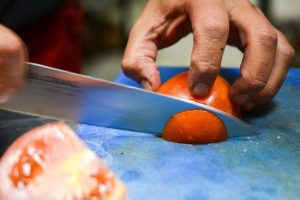 Also, it’s important to learn how to use the knife properly. That is a topic for a whole separate coaching tip, but there are many sites that will teach you how to properly use a Chef’s knife. (Yes, there is a right way and a wrong way!)
Also, it’s important to learn how to use the knife properly. That is a topic for a whole separate coaching tip, but there are many sites that will teach you how to properly use a Chef’s knife. (Yes, there is a right way and a wrong way!)
- The first thing to learn is how to hold the knife. Believe it or not, there is a proper way to hold the knife…not only so it can be used most efficiently, but also to protect the 5 digits on your other hand!
- Most people place their index finger and thumb on either side of the blade next to the handle (this is where the “bolster” can be useful) with their other fingers loosely curled around the handle (almost like you are shaking hands with the knife).
- Your other hand (the one holding the food you are cutting) should be in a claw grip with your fingers curled inward…this way your fingers are not in the danger zone!
Our “go-to” is a Japanese-style knife and we absolutely love it, but remember there are lots of good options out there. Once you get used to using a good Chef’s knife, it will make your cooking experience even more enjoyable!
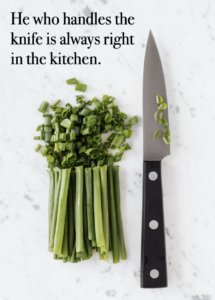 This, of course, is one of our goals at Eat REAL America…to make cooking and enjoying REAL meals easy and enjoyable!
This, of course, is one of our goals at Eat REAL America…to make cooking and enjoying REAL meals easy and enjoyable!
We would love to hear your feedback and thoughts on your favorite “go-to” chef’s knife and other kitchen tools!
 LEARN MORE ABOUT THE NAPKIN!
LEARN MORE ABOUT THE NAPKIN!
I absolutely agree with this article. After many, many years of not having a good knife, I was given one by a great friend and I love it! Is is amazing how easy it is to work with everything from squash down to baby carrots.
We agree…we use ours for everything! A good chef’s knife can give you a whole new level of joy in the kitchen!
I use an amazing chefs knife from IKEA…who would have known and I have had it for several years.
And probably many more years of good use still ahead!